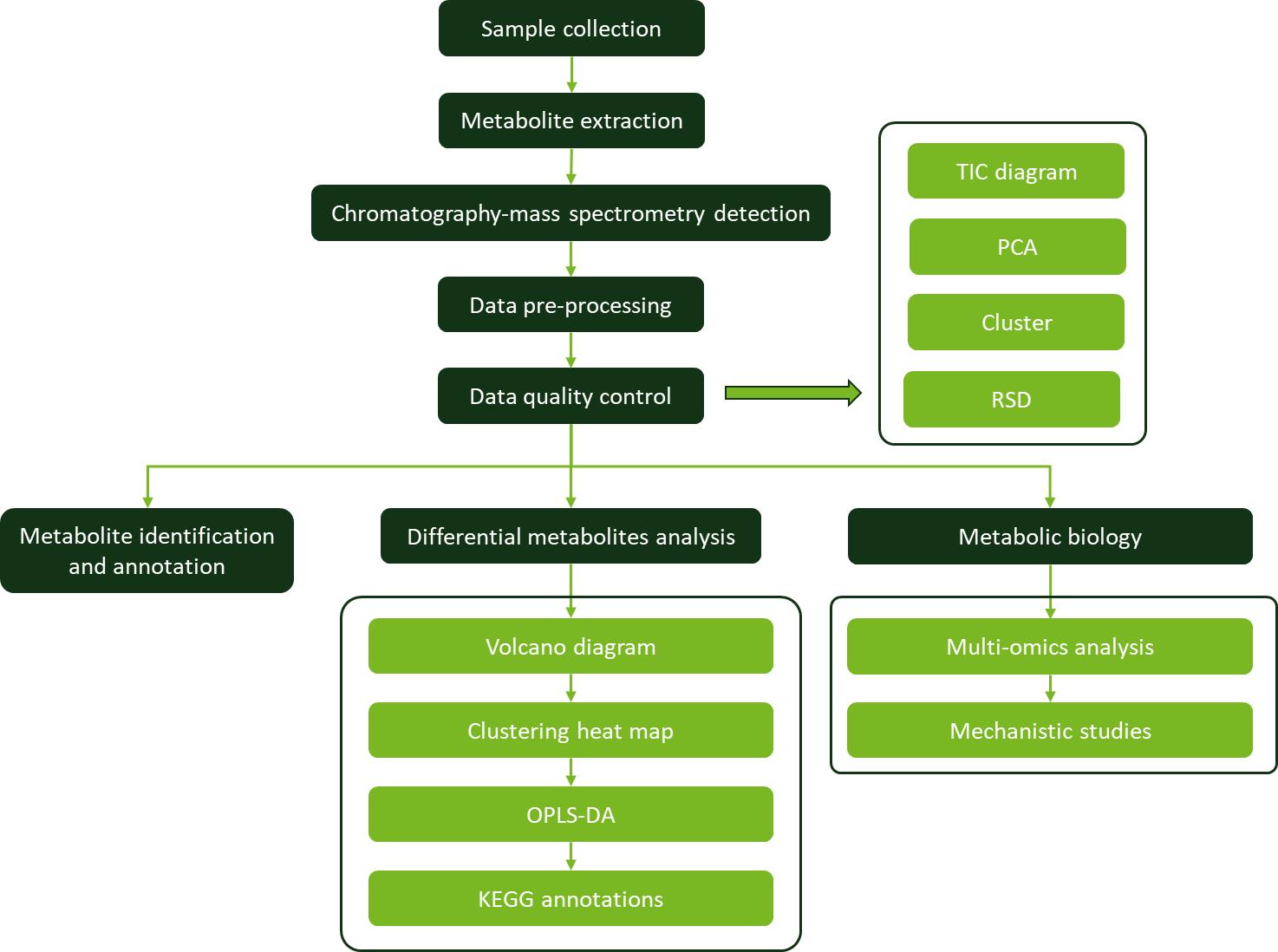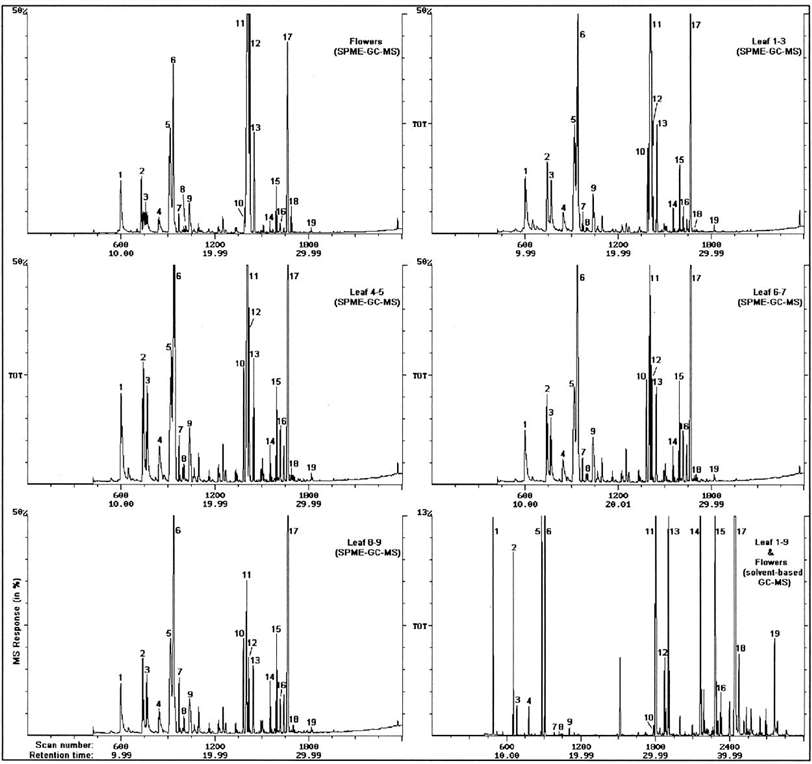What is Monoterpene?
Monoterpenes, also referred to as C10 isoprenoids, are a significant class of terpenes composed of two isoprene units, each consisting of five carbon atoms, resulting in a total of ten carbon atoms in the molecule. These isoprene units can be arranged in various structural configurations, including linear chains and cyclic forms. Monoterpenes are among the most prevalent and diverse groups of natural products found in the plant kingdom, playing crucial roles in plant physiology and ecology.
Monoterpenes analysis is crucial for understanding the composition and properties of essential oils and plant extracts. By quantifying and identifying monoterpenes, this analysis aids in quality control, ensures consistency in fragrance and flavor profiles, and supports research into their biological activities. It also plays a significant role in the food, fragrance, and pharmaceutical industries by ensuring the effectiveness and safety of products derived from these compounds.
Monoterpene Analysis Services by Creative Proteomics
At Creative Proteomics, we offer tailored plant target metabolomics analysis to meet unique research needs. For the monoterpenes analysis services, it is designed to cater to a wide range of industries. Our services include both qualitative and quantitative analysis of monoterpenes across various matrices. Here are the specific services we provide:
1. Comprehensive Monoterpene Profiling
We offer detailed profiling of monoterpenes in plant extracts, essential oils, and other complex matrices. This service identifies and quantifies the various monoterpenes present, providing a complete overview of the sample composition.
2. Targeted Monoterpene Quantification
For clients requiring specific analysis, we provide targeted quantification of individual monoterpenes such as linalool, limonene, geraniol, and others. This service is particularly useful for product development, quality control, and research applications.
3. Monoterpene Analysis in Food and Beverages
Our services extend to the food and beverage industry, where we analyze monoterpenes in products like beer, wine, and fruit juices. This analysis helps in flavor profiling, quality assurance, and regulatory compliance.
4. Essential Oils Composition Analysis
We specialize in the analysis of essential oils, determining the concentration and composition of monoterpenes. This service is vital for the fragrance and cosmetic industries, ensuring product consistency and efficacy.
5. Agricultural and Environmental Monoterpene Analysis
We provide analysis of monoterpenes in agricultural products and environmental samples. This service supports research in plant biology, pest management, and environmental monitoring.
6. Custom Monoterpene Analysis
For unique or specialized needs, we offer custom monoterpene analysis services. Our team works closely with clients to develop tailored analytical methods that meet specific project requirements.
List of Monoterpene Analyzed (including but not limited to)
Analytical Techniques and Instrumentation for Monoterpene Analysis
Creative Proteomics employs cutting-edge techniques and instrumentation for the accurate detection, identification, and quantification of monoterpenes. Our analytical platform includes the following methodologies:
Gas Chromatography-Mass Spectrometry (GC-MS): GC-MS is the gold standard for the analysis of volatile compounds, including monoterpenes. This technique combines the separation capabilities of gas chromatography with the sensitivity and specificity of mass spectrometry, allowing for the precise identification and quantification of monoterpenes in complex mixtures. GC-MS is particularly well-suited for analyzing essential oils and other plant-derived samples.
High-Performance Liquid Chromatography-Mass Spectrometry (HPLC-MS): HPLC, coupled with MS, is employed for the analysis of non-volatile monoterpene derivatives. This technique is particularly useful for the analysis of monoterpenes in complex biological matrices, where volatile compounds may be challenging to analyze using GC-MS alone.

Applications of Monoterpene Analysis
Pharmaceutical Applications: Monoterpenes possess a wide range of pharmacological properties, including anti-inflammatory, antimicrobial, antioxidant, and anticancer activities. Accurate analysis of monoterpenes is essential for the development of pharmaceuticals and nutraceuticals that harness these bioactive compounds. For instance, monoterpenes such as limonene and geraniol are investigated for their potential use in cancer therapies and as anti-inflammatory agents.
Flavor and Aroma Profiling in Food and Beverages: Monoterpenes are critical components of flavor and aroma in many food and beverage products. Their analysis is crucial for quality control, flavor formulation, and ensuring the consistency of sensory attributes. For example, the citrusy aroma of limonene is a key flavor compound in beverages, and its precise quantification is necessary to maintain product quality.
Fragrance and Skincare in Cosmetics: The cosmetic industry extensively uses monoterpenes in fragrances, skincare products, and hair care formulations. These compounds contribute not only to the pleasant scent but also to the therapeutic properties of cosmetic products. Analysis of monoterpenes ensures the stability, safety, and efficacy of these formulations.
Agricultural Enhancements: Monoterpenes play a significant role in plant defense mechanisms and are used in agriculture as natural pesticides or plant growth regulators. Analyzing monoterpenes in plants can provide insights into plant health, pest resistance, and the effectiveness of biopesticides.
Environmental Impact: Monoterpenes contribute to atmospheric chemistry by forming aerosols that influence cloud formation and climate. Monitoring the levels of monoterpenes in the environment is important for understanding their impact on air quality, climate change, and forest fire propagation.
Sample Requirements for Monoterpene Analysis
| Sample Types |
Sample Size |
Biological Repeat |
| Plant Samples |
-Essential oils (e.g., lavender oil)
-Plant extracts (e.g., rosemary extract)
-Whole plants (e.g., mint leaves) |
5 g (fresh), 2 g (dried) |
3-6 |
| Liquid Samples |
-Beverages (e.g., wine, beer)
-Essential oil solutions
-Fruit juices (e.g., orange juice) |
10 mL |
| Specialty Samples |
-Environmental samples (e.g., soil, air samples)
-Agricultural products (e.g., harvested crops)
-Synthetic mixtures (e.g., formulated products) |
5 grams or 10 mL |
Case. Monoterpene Composition of Essential Oil from Peppermint (Mentha × piperita L.) with Regard to Leaf Position Using Solid-Phase Microextraction and Gas Chromatography/Mass Spectrometry Analysis
Background
Solid-phase microextraction (SPME) is an efficient method for extracting organic volatiles from various sample sources, offering an alternative to traditional techniques like steam distillation and solvent extraction. Since its commercial introduction in 1993, SPME has seen extensive application in biological and chemical sciences. This study focuses on evaluating semiquantitative differences in essential oil quality from different parts of Mentha × piperita L., considering the impact of leaf position and harvest time.
Samples
Plant Material: Leaves and flowers of Mentha × piperita (clone Hardanger) were harvested from trial plots in Trondheim, Norway, in September 1997.
Preparation: Samples were dried at 35°C for 48 hours in a fan-assisted drying cabinet. Dried samples were stored at room temperature before analysis.
Technical Methods Procedure
Hydrodistillation:
50 grams of dried plant material were combined with 1.5 liters of water.
Distillation was conducted for 2 hours after reaching the boiling point at 100°C.
The oil was collected and stored in brown glass flasks at 4°C.
GC samples were prepared by diluting 10 μL of oil in 1 mL of ethanol.
SPME and GC/MS Setup:
The fiber was exposed to the GC inlet for thermal desorption at 250°C before sampling.
Samples were sealed in 10 mL vials and stored for 24 hours at 25°C.
The fiber was exposed to each sample for 1 minute at 25°C and then inserted into the GC for desorption.
Results
Both SPME−GC/MS and solvent-based GC/MS detected key compounds: menthol, menthyl acetate, menthone, and menthofuran.
SPME favored high-volatile compounds like α- and β-pinene, limonene, and 1,8-cineole.
Menthone increased, and menthol decreased from apical to basal leaves. Peppermint flowers contained four times more menthofuran compared to leaves.
The results aligned with previous studies, suggesting optimal harvest should occur when the plant has more basal leaves for higher menthol concentration and lower menthone levels.
 GC/MS profiles of headspace SPME of flowers and leaf pairs of peppermint compared with solvent-based GC/MS analysis (flower and leaf essential oil).
GC/MS profiles of headspace SPME of flowers and leaf pairs of peppermint compared with solvent-based GC/MS analysis (flower and leaf essential oil).
Reference
- Rohloff, Jens. "Monoterpene composition of essential oil from peppermint (Mentha× piperita L.) with regard to leaf position using solid-phase microextraction and gas chromatography/mass spectrometry analysis." Journal of Agricultural and Food Chemistry 47.9 (1999): 3782-3786.



 GC/MS profiles of headspace SPME of flowers and leaf pairs of peppermint compared with solvent-based GC/MS analysis (flower and leaf essential oil).
GC/MS profiles of headspace SPME of flowers and leaf pairs of peppermint compared with solvent-based GC/MS analysis (flower and leaf essential oil).




